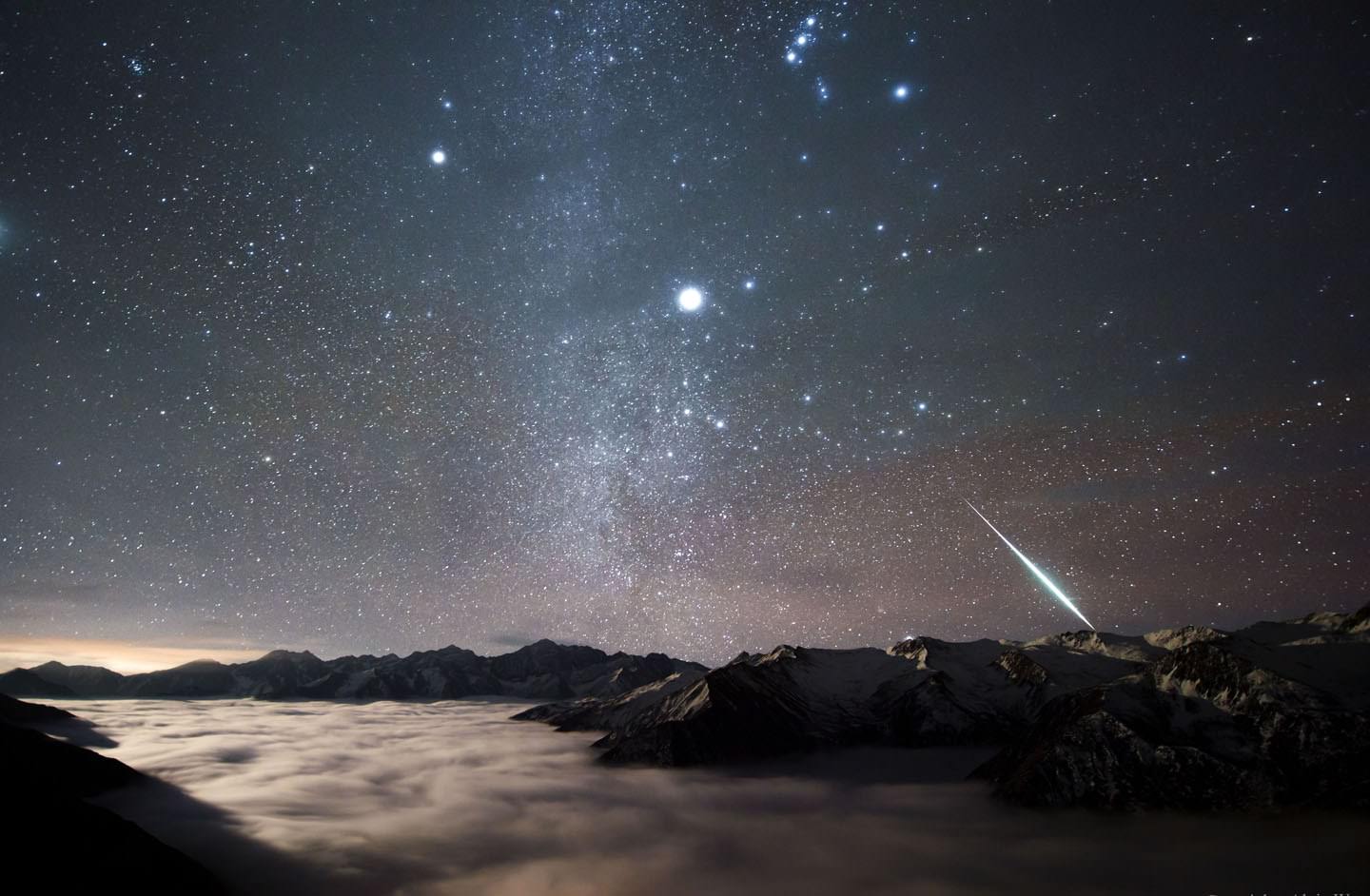2015 looks like a fantastic year for the
. With the Moon just 3 days past new and setting at the end of evening twilight, conditions couldn't be more ideal. Provided the weather cooperates! But even there we get a break. With a maximum of 120 meteors per hour, the shower is expected to peak around 18:00 UT (1 p.m. EST, 10 a.m. PST) December 14th, making for
two
nights of approximately equal activity: Sunday night Dec. 13-14 and Monday night Dec. 14-15.
[caption id="attachment_123773" align="aligncenter" width="580"]
You can start watching for Geminids early in the evening both Sunday and Monday nights (Dec. 13-14). The shower radiant lies right next door to the bright stellar duo Castor and Pollux in the constellation Gemini above Orion. Source: Stellarium[/caption]
That 120 meteor tally would be what you'd see from a dark, moonless sky with the radiant at the zenith.
Your
count will vary depending on whether you observe from the suburbs or the countryside and what time of night you go out. Closer to 50 per hour from locations near moderate-sized cities might be more realistic. Many meteor showers require getting up in the wee hours of the morning when the radiant has climbed high enough for a good view. Happily, the Geminids are different. The shower radiant already stands some 30° high in the eastern sky at 10 o'clock local time, making for a good hour of meteor-watching before you hit the hay Sunday night.
[caption id="attachment_123775" align="aligncenter" width="580"]
Two needle-like Geminids flash through the view in this photo taken during the 2012 maximum. Geminid meteors are markedly slower than the summer Perseids (about half as fast) but have their share of fireballs. Credit: Bob King[/caption]
Gemini crosses the meridian high in the southern sky for skywatchers at mid-northern latitudes around 2 a.m. this weekend — the time you'd expect to see the most meteors per hour. But hey, who's counting? Find a location with a wide-open view of the sky and tuck yourself under a sleeping bag in a comfy reclining chair. Creature comforts like coffee or a radio playing softly in the background will make you feel like you never had it so good. Then stare off into space and let come what may.,
Because all shower meteors arrive on parallel paths traveling at the same speed, they appear to radiate from a single point in the sky. The
is nothing more than a perspective effect, the very same as railroad tracks appearing to converge in the distance. Meteors near the radiant leave very short trails; the farther away you look, the longer the trail.
It's not necessary to directly face the radiant because shower meteors appear all over the sky. During the evening, I typically turn my chair to face east-southeast with the radiant off to one side. In the wee hours, with the radiant nearly overhead, I face south instead.
According to the
International Meteor Organization
(IMO), mass-sorting of debris within the Geminid stream will lead to an abundance of fainter, telescopic meteors about a day prior to visual maximum. If you happen to be out on Dec. 12-13 looking at deep sky objects through your telescope, you might notice a surfeit of faint meteors zipping through the field of view.
[caption id="attachment_123774" align="aligncenter" width="580"]
Graph of Geminids activity in December 2014 showing a maximum zenithal hourly (ZHR) rate of 253 meteors an hour. Observers in the southern hemisphere can also watch the shower, but hourly meteor counts will be much lower (20-30 per hour) because Gemini hunkers low in the northern sky. Credit: IMO[/caption]
Be sure to watch the
during peak shower activity. Click the
and then
2015
Geminids
to watch the data flow in from observers around the planet. The IMO invites you to share your observations of the shower by doing a scientific meteor count. Click
for instructions.
Unlike the August Perseids, the Geminid shower is a relative newcomer. It apparently
when English observer R. P. Greg noticed a new meteor radiant in Gemini active between Dec. 10-12. By the 1870s, more and more astronomers began observing the shower and making counts. Although they "tiptoed in" at first with maxima of 20 meteors per hour in the late 1890s, the shower ramped up to 50 per hour by the 1930s and 80 per hour in the 1970s. Now it's over a 100.
[caption id="attachment_117159" align="aligncenter" width="580"]
Composite image showing Geminids over Pendleton, Oregon. Credit: Thomas W. Earle[/caption]
Most showers are spawned by bits and pieces of dust and debris that drift away from an active comet to create a stream of orbiting debris. When Earth's path intersects the stream, dust strikes the atmosphere, heats up and creates a glowing tube of ionized air overhead we call a meteor. The parent of the Geminids was finally tracked down in the 1980s. Surprise! It turned out to be an
asteroid —
. Debris released by the asteroid, perhaps during its routine close approaches to the Sun, make the Geminids one of only two major showers (the other is the January Quadrantids) to originate from an asteroid.
Consistent and reliable, the Geminid shower is not to miss this year. Clear skies!
 Universe Today
Universe Today
